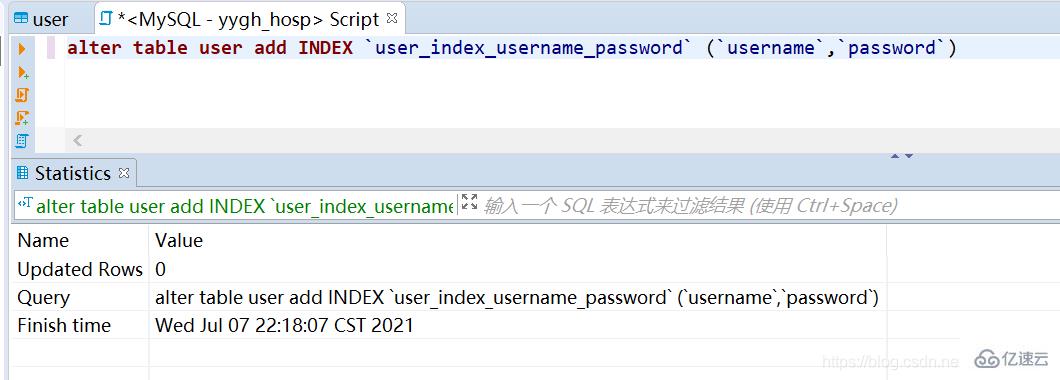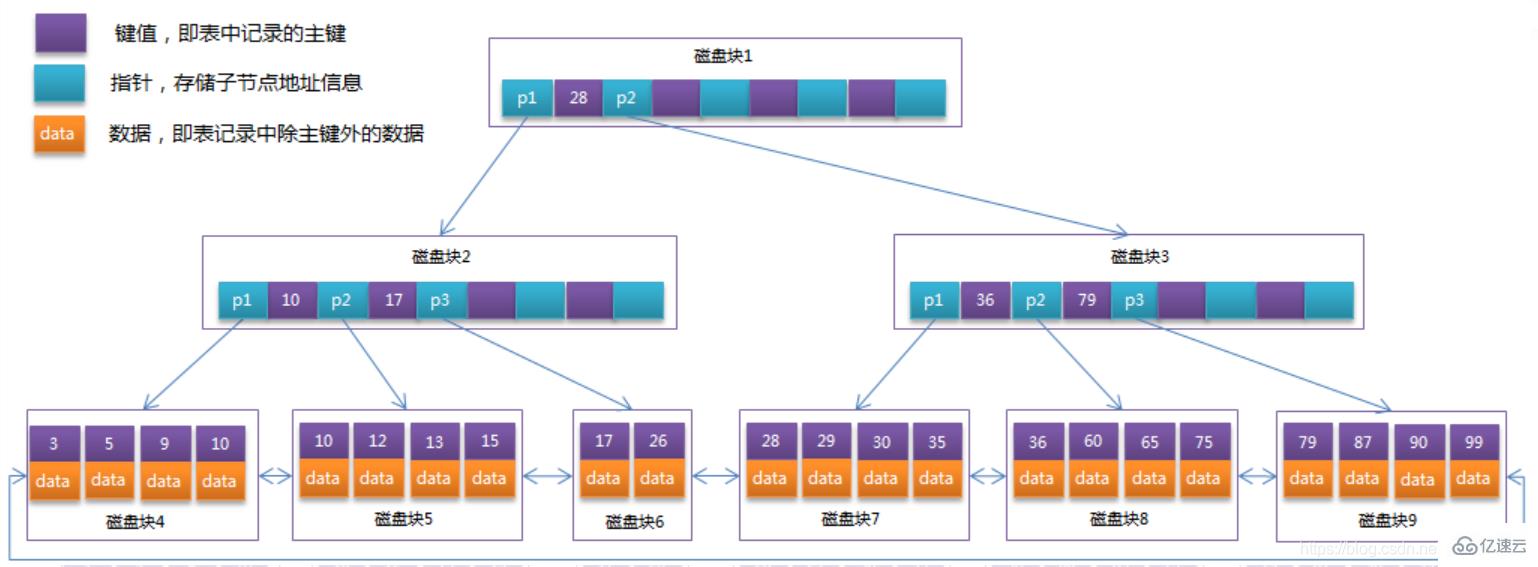What are the uses of indexes in MySQL
Index
1. Advantages of index
(1) Improve query efficiency (reduce IO usage)
(2) Reduce CPU Usage rate
For example, querying order by age desc, because the B index tree itself is sorted, so if the index is triggered by the query, there is no need to query again.
2. Disadvantages of indexes
(1) The index itself is large and can be stored in memory or on the hard disk, usually on the hard disk.
(2) Indexes are not used in all situations, such as ① a small amount of data ② frequently changing fields ③ rarely used fields
(3) Indexes will reduce the efficiency of additions, deletions and modifications
3. Index classification
(1) Single value index
(2) Unique index
(3) Union index
(4) Primary key index
Note: The only difference between unique index and primary key index: primary key index cannot be null
4. Create index
alter table user add INDEX `user_index_username_password` (`username`,`password`)

5. MySQL index principle-> B tree
The underlying data structure of MySQL index is B tree
B Tree is in B- An optimization based on Tree makes it more suitable for implementing external storage index structures. The InnoDB storage engine uses B Tree to implement its index structure.
Each node in the B-Tree structure diagram contains not only the key value of the data, but also the data value. The storage space of each page is limited. If the data data is large, the number of keys that can be stored in each node (i.e. one page) will be very small. When the amount of stored data is large, it will also lead to B- The depth of Tree is larger, which increases the number of disk I/Os during query, thereby affecting query efficiency. In B Tree, all data record nodes are stored on leaf nodes of the same layer in order of key value. Only key value information is stored on non-leaf nodes. This can greatly increase the number of key values stored in each node. Reduce the height of B Tree.
B Tree has several differences compared to B-Tree:
Non-leaf nodes only store key value information.
There is a link pointer between all leaf nodes.
Data records are stored in leaf nodes.
Optimize the B-Tree in the previous section. Since the non-leaf nodes of B Tree only store key value information, assuming that each disk block can store 4 key values and pointer information, it will become the structure of B Tree. As shown in the figure below:

Usually there are two head pointers on the B Tree, one points to the root node, the other points to the leaf node with the smallest keyword, and all leaf nodes ( That is, there is a chain ring structure between data nodes). Therefore, two search operations can be performed on B Tree: one is a range search and paging search for the primary key, and the other is a random search starting from the root node.
Maybe there are only 22 data records in the above example, and the advantages of B Tree cannot be seen. Here is a calculation:
The page size in the InnoDB storage engine is 16KB, and the primary key type of the general table It is INT (occupies 4 bytes) or BIGINT (occupies 8 bytes), and the pointer type is generally 4 or 8 bytes, which means that one page (a node in B Tree) stores approximately 16KB/( 8B 8B) = 1K key values (because it is an estimate, to facilitate calculation, the value of K here is 〖10〗^3). In other words, a B Tree index with a depth of 3 can maintain 10^3 * 10^3 * 10^3 = 1 billion records.
In actual situations, each node may not be fully filled, so in the database, the height of B Tree is generally between 2 and 4 levels. MySQL's InnoDB storage engine is designed so that the root node is resident in memory, which means that only 1 to 3 disk I/O operations are needed to find the row record of a certain key value.
The B Tree index in the database can be divided into clustered index (clustered index) and auxiliary index (secondary index). The above B Tree example diagram is implemented in the database as a clustered index. The leaf nodes in the B Tree of the clustered index store the row record data of the entire table. The difference between an auxiliary index and a clustered index is that the leaf nodes of the auxiliary index do not contain all the data of the row record, but the clustered index key that stores the corresponding row data, that is, the primary key. When querying data through a secondary index, the InnoDB storage engine traverses the secondary index to find the primary key, and then finds the complete row record data in the clustered index through the primary key.
The above is the detailed content of What are the uses of indexes in MySQL. For more information, please follow other related articles on the PHP Chinese website!

Hot AI Tools

Undresser.AI Undress
AI-powered app for creating realistic nude photos

AI Clothes Remover
Online AI tool for removing clothes from photos.

Undress AI Tool
Undress images for free

Clothoff.io
AI clothes remover

Video Face Swap
Swap faces in any video effortlessly with our completely free AI face swap tool!

Hot Article

Hot Tools

Notepad++7.3.1
Easy-to-use and free code editor

SublimeText3 Chinese version
Chinese version, very easy to use

Zend Studio 13.0.1
Powerful PHP integrated development environment

Dreamweaver CS6
Visual web development tools

SublimeText3 Mac version
God-level code editing software (SublimeText3)

Hot Topics
 1664
1664
 14
14
 1423
1423
 52
52
 1318
1318
 25
25
 1269
1269
 29
29
 1248
1248
 24
24
 MySQL's Role: Databases in Web Applications
Apr 17, 2025 am 12:23 AM
MySQL's Role: Databases in Web Applications
Apr 17, 2025 am 12:23 AM
The main role of MySQL in web applications is to store and manage data. 1.MySQL efficiently processes user information, product catalogs, transaction records and other data. 2. Through SQL query, developers can extract information from the database to generate dynamic content. 3.MySQL works based on the client-server model to ensure acceptable query speed.
 Laravel Introduction Example
Apr 18, 2025 pm 12:45 PM
Laravel Introduction Example
Apr 18, 2025 pm 12:45 PM
Laravel is a PHP framework for easy building of web applications. It provides a range of powerful features including: Installation: Install the Laravel CLI globally with Composer and create applications in the project directory. Routing: Define the relationship between the URL and the handler in routes/web.php. View: Create a view in resources/views to render the application's interface. Database Integration: Provides out-of-the-box integration with databases such as MySQL and uses migration to create and modify tables. Model and Controller: The model represents the database entity and the controller processes HTTP requests.
 MySQL and phpMyAdmin: Core Features and Functions
Apr 22, 2025 am 12:12 AM
MySQL and phpMyAdmin: Core Features and Functions
Apr 22, 2025 am 12:12 AM
MySQL and phpMyAdmin are powerful database management tools. 1) MySQL is used to create databases and tables, and to execute DML and SQL queries. 2) phpMyAdmin provides an intuitive interface for database management, table structure management, data operations and user permission management.
 MySQL vs. Other Programming Languages: A Comparison
Apr 19, 2025 am 12:22 AM
MySQL vs. Other Programming Languages: A Comparison
Apr 19, 2025 am 12:22 AM
Compared with other programming languages, MySQL is mainly used to store and manage data, while other languages such as Python, Java, and C are used for logical processing and application development. MySQL is known for its high performance, scalability and cross-platform support, suitable for data management needs, while other languages have advantages in their respective fields such as data analytics, enterprise applications, and system programming.
 Solve database connection problem: a practical case of using minii/db library
Apr 18, 2025 am 07:09 AM
Solve database connection problem: a practical case of using minii/db library
Apr 18, 2025 am 07:09 AM
I encountered a tricky problem when developing a small application: the need to quickly integrate a lightweight database operation library. After trying multiple libraries, I found that they either have too much functionality or are not very compatible. Eventually, I found minii/db, a simplified version based on Yii2 that solved my problem perfectly.
 Laravel framework installation method
Apr 18, 2025 pm 12:54 PM
Laravel framework installation method
Apr 18, 2025 pm 12:54 PM
Article summary: This article provides detailed step-by-step instructions to guide readers on how to easily install the Laravel framework. Laravel is a powerful PHP framework that speeds up the development process of web applications. This tutorial covers the installation process from system requirements to configuring databases and setting up routing. By following these steps, readers can quickly and efficiently lay a solid foundation for their Laravel project.
 MySQL for Beginners: Getting Started with Database Management
Apr 18, 2025 am 12:10 AM
MySQL for Beginners: Getting Started with Database Management
Apr 18, 2025 am 12:10 AM
The basic operations of MySQL include creating databases, tables, and using SQL to perform CRUD operations on data. 1. Create a database: CREATEDATABASEmy_first_db; 2. Create a table: CREATETABLEbooks(idINTAUTO_INCREMENTPRIMARYKEY, titleVARCHAR(100)NOTNULL, authorVARCHAR(100)NOTNULL, published_yearINT); 3. Insert data: INSERTINTObooks(title, author, published_year)VA
 Solve MySQL mode problem: The experience of using the TheliaMySQLModesChecker module
Apr 18, 2025 am 08:42 AM
Solve MySQL mode problem: The experience of using the TheliaMySQLModesChecker module
Apr 18, 2025 am 08:42 AM
When developing an e-commerce website using Thelia, I encountered a tricky problem: MySQL mode is not set properly, causing some features to not function properly. After some exploration, I found a module called TheliaMySQLModesChecker, which is able to automatically fix the MySQL pattern required by Thelia, completely solving my troubles.




